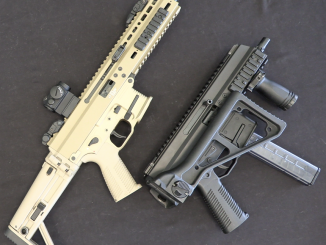Designed by Adolf Furrer, this carbine represents a very early experiment with intermediate power ammunition. It is a long recoil semiautomatic carbine with an under barrel tube magazine – quite the interesting combination of 19th and 20th centuries! The cartridge used was the experimental Swiss 7.65x27mm, and a similar but slightly longer 7.65x35mm was also used. These were loaded with round nosed bullets, although spitzer bullets would be used in later prototypes with box magazines.
Furrer was the director of the WF Bern factory, and in an excellent position to develop this type of porto-assault rifle. This particular example is one of 5 of its type made, and is one of the very first of his designs of the type. Development would continue for many years, but the concept was not taken up by Swiss armed forces. These guns and their ammunition would be revisited right after World War 2 and more experimental guns made, but would again be ultimately rejected in favor of the Stgw-57 in 7.5x55mm.




“The cartridge used was the experimental Swiss 7.65x27mm, and a similar but slightly longer 7.65x35mm was also used.”
Dimensions and photos of later: http://www.municion.org/Swiss/765x38Furrer.htm
Interestingly municion has also entry of variant of this cartridge
http://www.municion.org/Swiss/765x38XG.htm
which (if I am not mistaken) was designed for export
Interestingly, apparently Hungary was also testing similar cartridge:
http://www.municion.org/7mm/7_65x30.htm
“(…)interesting combination of 19th and 20th centuries(…)”
I would it is typical work of Adolf Furrer, which is working properly, but also of complicated design and expensive to manufacture, even by then used standards.
He designed MP 41/44 which was adopted into Swiss service (due to something which today would be called LOBBY – more info read here: https://wwiiafterwwii.wordpress.com/2016/07/31/mp-4144-submachine-gun-post-wwii-use/ )
On the good hand he want to use bakelite furniture, but proved be not strong enough in service. It was heavier than it needs to be and more complicated than it needs to be.
In fact finally Switzerland decided to switch for license-made SUOMI sub-machine guns (as Mp. 43/44), because it was cheaper (yes, SUOMI, one of more expensive 1930s sub-machine gun)
Another example of Furrer work is W+F 1919, see photo:
http://zonwar.ru/pp/WF-1919.html
which was also heavy (though in 1919 it might be accepted) and also don’t use simple blow-back, but knee-joint (though rotated “to side” in comparison with Luger 1900, see photo in link), despite it wasn’t blow-back it neither give lesser mass of whole weapon or more moderate rate-of-fire (that weapon fired 1380 rpm). On good side it has magazine of capacity 50 (two-column) and bolt hold-open (it will remain open after last shot).
In 1919-1921 years 92 examples were made, Swiss army adopted it in May 1940, when they needed ANY sub-machine gun.
Considering that Switzerland produced better-suited-for-mass-production sub-machine gun in interbellum, like for example BREVET BERGMANN
http://modernfirearms.net/smg/switch/sig-1920-1930-e.html
I would describe Furrer as blind, both as constructor (unable to admit that someone design might be better) and as citizen of Switzerland (as his action caused waste of labor)
He was the expensive gunsmithing’s Rube Goldberg
Furrer was more or less blinded by his own pride, seeing as his toggle-locked weapons were his greatest achievements.
What comes to my mind at the moment is the difference between terms “designer” and “inventor”. Furrer wanted to be inventor. At his time there was not much need to invent, but to look around and copy; cut and paste, as we say today. He was ‘enjoying’ himself apparently.
That longer cartridge was not too shabby, probably good plinker to 200m.
“inventor(…)copy”
In fact his sub-machine gun seem to be dwarf-version of earlier W+F Lmg-25: http://modernfirearms.net/machine/switch/wf-lmg-25-e.html
also designed by Furrer, thus it looks that Furrer must believe in superiority of Kniegelenkverschluss.
It is bad that Furrer can’t admit that someone else design is better, but worse yet – he didn’t want to implement someone else inventions even if it can give better weapon.
“longer cartridge was not too shabby”
What that mean?
Not too shabby – not visibly underpowered. This is not fact backed statement since I have no knowledge of its mv and E. Just visual assessment.
Reverse engineering is difficult–and without detailed diagrams and a decent user’s manual, it would take reverse engineering to figure out that prototype.
The interesting and unanswered questions were “did it work?” “What was the hit probability at combat distances?” “Was it fragile or durable?”
How well did it handle without ammo? Was it easy to shoulder using just one hand?
I don’t know about its military utility, but with a scope on top I could see it as a light sporting rifle for deer, etc., especially in Europe. The internal tube magazine would seem made to order for that job.
As for the long recoil action, the Browning Auto-5 shotgun had such an action as well, and nobody ever complained about its practicality.
cheers
eon
“As for the long recoil action, the Browning Auto-5 shotgun had such an action as well, and nobody ever complained about its practicality.”
See Remington Model 8 for another example of long recoil.
Yeah, those are also known as good kickers.
Franchi were still making a derivative of the Browning long recoil shot gun last time I looked.
The game keeper in the village where I live has just changed his shot gun. He’s a tough customer, and has demonstrated it numerous times dealing with poachers who tried to fight.
One shot with his old, work, Spanish side by side, with an Italian made cartridge, headstamped RC, and he thought he’d broken a finger and lost teeth.
I’m guessing that those cartridges wouldn’t be pleasant out of a long recoil Browning, either.
Errrr, Ian: why does the thumbnail pic show a Ljutic Spacegun?
Oops! Because I goofed, that’s why. 🙂
I assume that’s something coming up? I have always wondered about those.
I don’t know whether it’s my hacked wifi connection, or YouTube playing silly buggers,
Approx two hours of messing about, and I’ve only managed to watch four minutes of the vid in approx 30 second chunks.
The FN Browning A5 shotgun and eventual Remington Model 8 rifle (there was an FN precursor) were both long recoil weapons but differed in both their magazines and their locking systems. The A5 had a rising block (powered by the breech return spring!) and the Model 8 a now-conventional rotating bolt. Accuracy from a solidly-locked breech would be the presumed motive for the rifle’s rotating bolt, along with the use of rimless cartridges. Also the rifle fed from a box magazine.
The A5 bolt handle seems to work like this gun — a very small unlocking pull, followed by the final pull that opens the bolt. I would agree with Mr. M’s assessment of the locking system (is the patent published anywhere?). I would surmise this might be a straight copy of the Browning A5, tube magazine and all, adapted to an intermediate rifle cartridge.
I’d like to know where the springs are on this weapon. One of Browning’s great accomplishments with the A5 was to make it LOOK like a fairly normal long arm of the period. He did this by hiding the springs in a devilishly clever manner: the barrel spring encircled the tube magazine and abutted a ring, welded (?) to the barrel, that also encircled the magazine; the whole business hidden inside the wooden fore-end. The breechblock recoil spring (which actually powered the locking block upwards, incidentally taking the breechblock forward for the ride) ran down into the buttstock, which was hollow.
Recoil on the A5 was ameliorated by an adjustable braking system of split rings and washers mounted around the tube magazine between spring and barrel ring. The recoil pushed a washer onto the beveled split ring, and squeezed it, thus slowing recoil. If you were shooting mild ammunition you removed the rings until the gun cycled successfully; if you loaded heavier charges you added rings and washers until the gun kicked the bolt back, but not so much your shoulder. The harder the recoil pushed, the more the rings squeezed, and for many loads the system was self-adjusting. Most complaints about A5 recoil come from shooters who have lost or are ignorant of their braking rings.
PS. It seems that Furrer departed from Browning on one issue: the A5 had a hammer; this seems to have a striker for ignition, unless somehow the cocking indicator was connected to a hammer or firing pin.